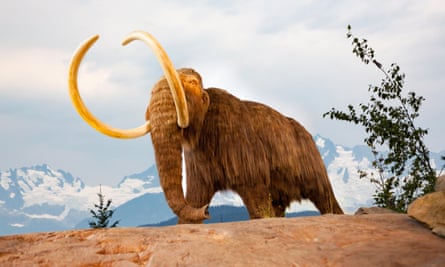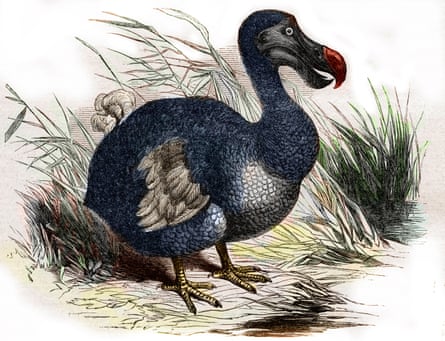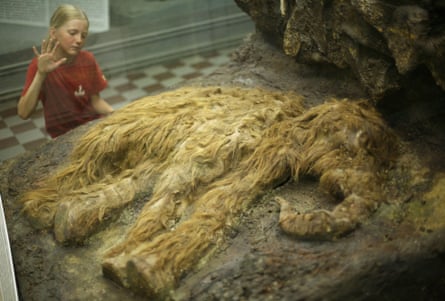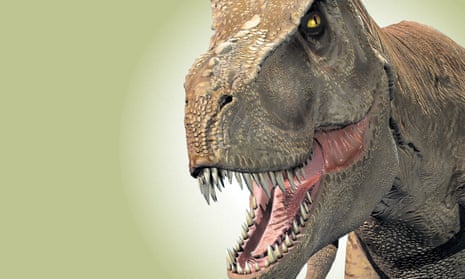What Alida Bailleul saw through the microscope made no sense. She was examining thin sections of fossilised skull from a young hadrosaur, a duck-billed, plant-eating beast that roamed what is now Montana 75m years ago, when she spotted features that made her draw a breath.
Bailleul was inspecting the fossils, from a collection at the Museum of the Rockies in Bozeman, Montana, to understand how dinosaur skulls developed. But what caught her eye should not, the textbooks said, be there. Embedded in calcified cartilage at the back of the skull were what appeared to be fossilised cells. Some contained tiny structures that resembled nuclei. In one was what looked like a clump of chromosomes, the threads that bear an organism’s DNA.
Bailleul showed the specimens to Mary Schweitzer, a professor and specialist in molecular palaeontology at North Carolina State University, who was visiting the museum. Schweitzer had done her PhD in Montana under the supervision of Jack Horner, the resident fossil hunter who inspired the Jurassic Park character Alan Grant. Schweitzer herself had become famous – and faced waves of criticism – for claiming to have found soft tissue in dinosaur fossils, from blood vessels to fragments of proteins.
Schweitzer was intrigued by Bailleul’s discovery and the two joined forces to study the fossils further. In early 2020, as the world was dealing with the arrival of Covid, they published a bombshell paper on their findings. Their report laid out not only evidence for dinosaur cells and nuclei in the hadrosaur fossils, but results from chemical tests that pointed to DNA, or something like it, coiled up inside.
The idea of recovering biological material from dinosaur fossils is controversial and profound. Schweitzer doesn’t claim to have found dinosaur DNA – the evidence is too weak to be sure – but she says scientists should not dismiss the possibility that it could persist in prehistoric remains.
“I don’t think we should ever rule out getting dinosaur DNA from dinosaur fossils,” she says. “We’re not there yet, and maybe we won’t find it, but I guarantee we won’t if we don’t continue to look.”
Scraps of prehistoric tissue, proteins or DNA could transform the field of molecular palaeontology and unlock many of the mysteries of dinosaurs’ lives. But the prospect of having the intact genetic code from a tyrannosaur or velociraptor raises questions scientists have become used to fielding since the original Jurassic Park movie in 1993. Armed with sufficient dino DNA, could we bring back the lumbering beasts?

Rapid advances in biotechnology have paved the way for elegant approaches to de-extinction, where a species once considered lost for ever gets a second shot at life on Earth. For now, the focus is on creatures that humans once shared the planet with – and which we helped to drive out of existence.
Arguably the most high-profile de-extinction programme aims to recreate, in some sense, the woolly mammoth and return herds of the beasts to the Siberian tundra thousands of years after they died out. The company behind the venture, Colossal, was founded by the Harvard geneticist George Church, and Ben Lamm, a tech entrepreneur, who claim that thousands of woolly mammoths could help to restore the degraded habitat: for example, by knocking down trees, fertilising the soil with their dung, and encouraging grasslands to regrow. If all goes to plan – and it may well not – the first calves could be born within six years.
What lies ahead is a formidable challenge. Despite well-preserved mammoths being dug out of the tundra, no living cells were found to clone them using the approach that produced Dolly the sheep, the first cloned mammal. So Colossal has devised a workaround. First, the team compared the genomes of the woolly mammoth and a close living relative, the Asian elephant. This revealed genetic variants that equipped the woolly mammoth for the cold: the dense coat of hair, the shortened ears, the thick layers of fat for insulation and so on.
The next step is to use gene editing tools to rewrite the genome of an Asian elephant cell. If the 50 or so expected edits have the desired effect, the team will insert one of the “mammothified” elephant cells into an Asian elephant egg that has had the nucleus removed. A zap of electricity will be applied to spark fertilisation and the egg should start to divide and grow into an embryo. Finally, the embryo will be transferred to a surrogate mother or, given the aim to produce thousands of the creatures, an artificial womb that can carry the foetus to term.
Colossal’s project highlights one of the greatest misunderstandings about de-extinction programmes. For all the talk of bringing species back, these will not be copies of extinct animals. Colossal’s woolly mammoth, as Church readily admits, will be an elephant modified to survive the cold.
Whether that matters depends on the motive. If the aim is to restore the health of an ecosystem, then the animal’s behaviour trumps its identity. But if the driver is nostalgia, or an attempt to assuage human guilt for destroying a species, de-extinction may be little more than a scientific strategy for fooling ourselves.

The California-based non-profit Revive and Restore has projects under way to help revive more than 40 species through the shrewd application of biotechnology. The organisation has cloned a black-footed ferret, named Elizabeth Ann, which is on course to become the first cloned mammal to help save an endangered species. The hope is that Elizabeth Ann, who was created from cells frozen in the 1980s, will bring much-needed genetic diversity to wild colonies of ferrets that are threatened by inbreeding.
Revive and Restore intends to bring back two extinct bird species, the heath hen and the passenger pigeon, as soon as the 2030s. After holding on for decades in Martha’s Vineyard, an island near Cape Cod in Massachusetts, the heath hen eventually died out in 1932. Under the de-extinction plan, scientists will create a replacement bird by editing the DNA of the closely related prairie chicken to carry heath hen genes. The passenger pigeon project takes a similar approach, using the band-tailed pigeon as the genetic template.
Ben Novak, the lead scientist at Revive and Restore, likens de-extinction to rewilding efforts that reintroduce lost species to improve local habitats. “Introducing biotechnology is simply expanding this existing practice to be able to consider species that were off the table before,” he says. To worry that animals created through de-extinction projects are not exact replicas of lost species is missing the point, he adds. “We are not recreating these species to satisfy human philosophy – we are doing this for conservation purposes. For conservation, what matters is an ecosystem, and ecosystems do not sit around pontificating on classification schemes,” he says.
Should humans try to prevent all future extinctions? Every species dies out at some point. But while extinction is normal in ecosystem evolution, human activity is driving species to the brink faster than most species can adapt. Novak says preventing all extinctions is a “good goal” but the reality, he adds, is that the world’s governments have not prioritised conservation over exploitation. “No matter how many people really work hard, we have the majority of humanity still working against that goal,” he says. “What we can do is prevent as many as possible right now, and re-diversify the world in a way that gives us the ecological stability to prevent further extinctions.”

The dodo is a prime candidate for de-extinction. Once native to Mauritius (and only Mauritius), the large, flightless bird died out in the 17th century after humans settled on the island. On top of the widespread destruction of its habitat, the dodo was further threatened by pigs, cats and monkeys that sailors brought with them.
A team led by Beth Shapiro, a professor of ecology and evolutionary biology at the University of California, Santa Cruz, has sequenced the dodo genome from a museum specimen in Copenhagen. In theory, a dodo-like bird could be created by editing the Nicobar pigeon genome to contain dodo DNA, but, as with all de-extinction projects, creating the animal is not enough: there has to be a habitat for it to thrive in, or the exercise becomes pointless.
“I think it’s crucial that, as we prioritise species and ecosystems for protection, we do so while considering what our planet will be like 50 or 100 years from now, rather than imagining that we can somehow turn back the clock and re-establish ecosystems of the past,” Shapiro says.
“The biggest problem many species face today is that the rate of change in their habitats is too fast for evolution to keep up. This is where our new technologies can be useful. We can sequence genomes and make more informed breeding decisions. We can resurrect lost diversity by cloning – like Elizabeth Ann, the black-footed ferret – and we may even be able to move adaptive traits between populations and species. Our new technologies may make it possible for us to increase the rate at which species can adapt, perhaps saving some from the same fate as the dodo and the mammoth,” she adds.

Most de-extinction projects are viable because researchers have either living cells or the entire genome from the lost species, and a close living relative that can be both genetic template and surrogate mother for the “resurrected” animal. In the case of dinosaurs, these may be insurmountable hurdles.
The work by Schweitzer, Bailleul and others challenges the textbook explanation of fossilisation as the wholesale replacement of tissue with rock: life turned literally to stone. They see a more complex process at work, with the fossilisation process occasionally preserving the molecules of life, for perhaps tens of millions of years.
But even if soft tissue can survive in fossils, that may not be true for dinosaur DNA. Genetic material starts to break down soon after death, so anything preserved could be highly fragmented. The oldest DNA yet recovered is from the tooth of a million-year-old mammoth preserved in the eastern Siberian permafrost. Older DNA may well be found, but will scientists be able to read the code and understand how it shaped the prehistoric creatures?
Other hurdles abound, Schweitzer says. Armed with the entire genome of Tyrannosaurus rex, researchers would have no idea how the genes were ordered on how many chromosomes. Solve that puzzle, somehow, and you still have to find a close living relative that can be gene-edited to carry the dinosaur genes. While birds are distant relatives of dinosaurs, an ostrich might struggle to carry a T rex to term. “You end up just going down the list,” says Schweitzer. “If we can solve this, then there’s this, and if we can solve this, then there’s this. I don’t think technology can overcome it, at least not in the foreseeable future.”
But what if life can find a way? An approach championed by Schweitzer’s former supervisor, Jack Horner, is to take a living relative of the dinosaur – the chicken – and rewrite its genome to make birds with dinosaur-like features. By tinkering with bird genomes, researchers have recreated dinosaur-like teeth, tails and even hands, similar to those on the velociraptor. Keep going, says Horner, and you end up with a “chickenosaurus”.
Technology cannot solve everything, though. A sustainable population, with healthy genetic variation, might call for 500 or so animals. “Where are we going to put them? And which modern species are you going to drive to extinction so that dinosaurs have a place again on this planet?” says Schweitzer. “We might be able to put one in a zoo for people to spend zillions of dollars to come and look at, but is that fair to the animal?”
Instead of trying to recreate the beasts, Schweitzer simply wants to understand them better. Organic molecules locked up in fossils could shed light on the endless mysteries that surround the dinosaurs. Did they produce enzymes to get more nutrition from plants? How did they cope with carbon dioxide levels more than twice as high as today? And how did they maintain their often enormous body sizes?
“I don’t think it’s unreasonable to suggest that as technology and our understanding of degradation catches up, we may get informative DNA,” she says. “Think of the questions we can answer if we do – that’s what I find exciting.
“I don’t hold my breath that we’ll ever see a dinosaur walking around. I’m not going to rule it out – a scientist should never say never – but I think it’s human hubris to bring back a dinosaur just so we can say we did it. We need to have more reason than that.”
